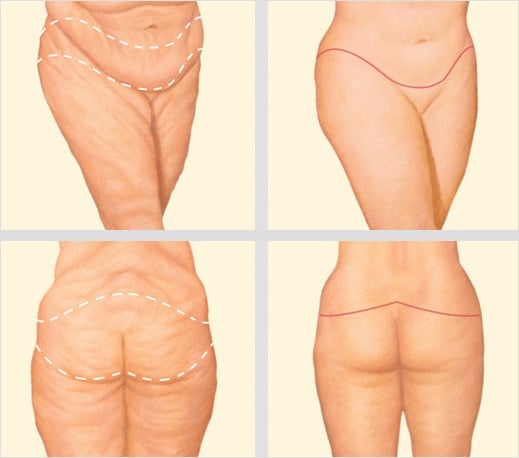Body Lift Surgery
When you lose weight, one of the more unfortunate side effects is that you are faced with an excess of skin sagging on your body. When you are overweight, your skin stretches to accommodate fat. Once undergoing weight loss surgery, or undertaking a lifestyle change using diet and exercise to lose the weight, your skin maintains its stretched appearance.
RELATED ARTICLES
It can be almost impossible for your skin to return to normal on its own, especially if you were excessively obese.
A body lift will lift and tighten the loose and excess skin that remains after you lose weight, so that you can show off the new shape that you have worked so hard to achieve.
 Before and After Body Lift Surgery; The incision (white dotted line) and scar lines (red line)
Before and After Body Lift Surgery; The incision (white dotted line) and scar lines (red line)
What Problems Does it Fix?
A body lift will typically address four major components of your body and body shape after dramatic weight loss, or even after the natural process of aging. It can help with the removal of extra fatty tissue and fat deposits, irregular body contouring after significant weight loss, removal of extra skin, and tightening of separated muscles.
A body lift can be done on any part of your body, however, the majority of body lift surgeries are concentrated on the lower region of the body, including midsection, thighs and buttocks. Different techniques are used for different body parts.
Who is Right for the Surgery?
Anyone who has excess skin can be a candidate for a body lift. It is not recommended for those who have not yet achieved a stable weight that they are happy with, but it can be used in conjunction with weight loss surgery to ensure that you are able to achieve the appearance that you wan. If you can pinch and pull on your skin, and see that it has some give, then you are a candidate for a body lift in that area.
How Do They Complete the Procedure?
The procedure begins with an incision along the upper and lower boundaries of wherever your body lift procedure is to take place. The excess skin is then cut off of the body between these boundaries. The previously marked upper and lower margins are then sewn together.
Scarring usually occurs where these areas are sewn together. In order to achieve the least intrusive scarring, many surgeons will have their patients model in a revealing outfit or bathing suit to ensure scarring is hidden when they are wearing these outfits.
Risks and Complications
Every surgery has risks and complications that cannot be negated when undergoing surgery. Every surgery has the potential to turn bad, no matter how skilled the surgeon may be. However, there are some risks and complications which are more typical than others. These include:
- Fluid build up
- Skin loss
- The wound does not heal properly
- Infection
- Unpleasant scarring
- Seroma
- Hemotoma
- Deep vein thrombosis
With a certified and experienced surgeon, however, this risks can be minimalized.
Recovery
Patients need complete bed rest for the first seven days. They should not take a shower, or remove the compression garment for this period, and should only leave the bed to use the bathroom. Patients should refrain from working and driving for at least the first four weeks, potentially longer if recovery is slow. Full patient recover, and resumption of normal activities takes at least 6 – 8 weeks.
How Much Does it Cost?
A typical body lift will cost anywhere from $18,000 to $20,000 if you have multiple areas in which you want to lift. The cost is completely dependent on the complexity of the overall surgeries.